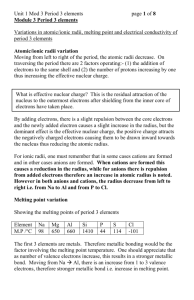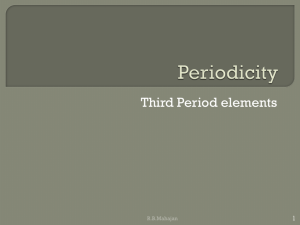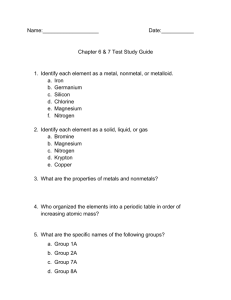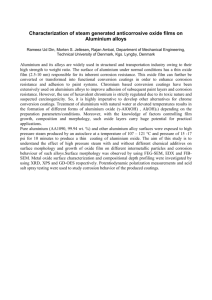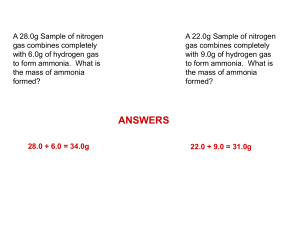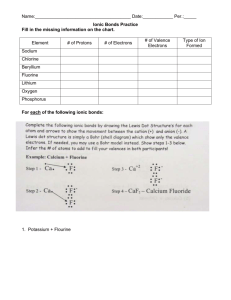Period 3 Reactions
advertisement
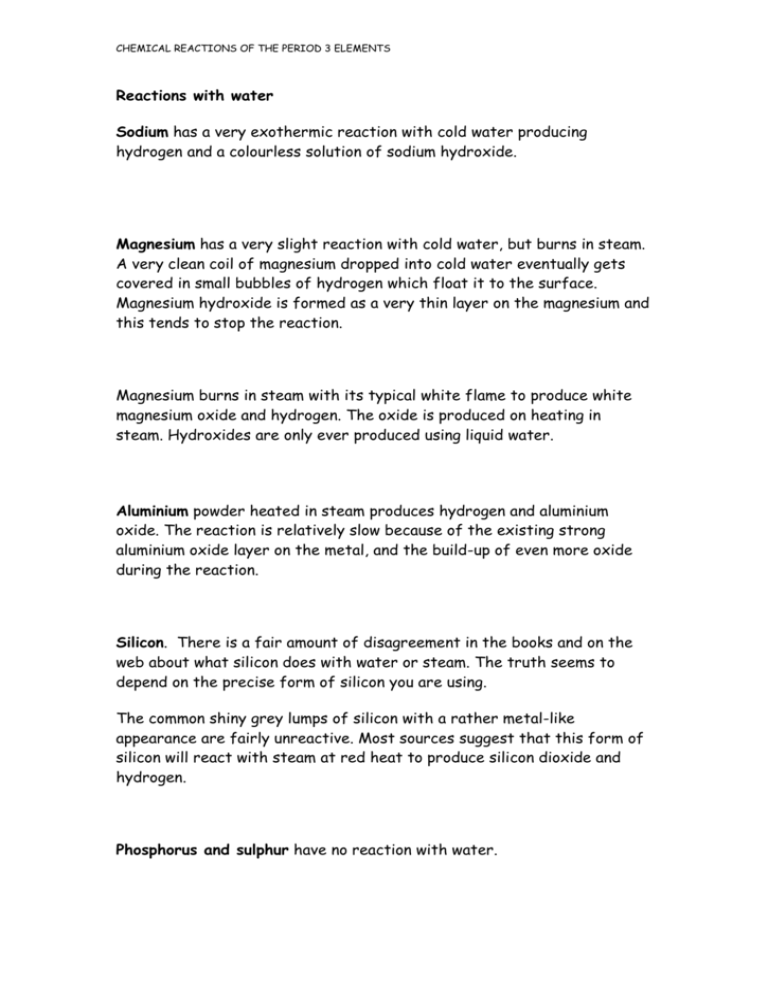
CHEMICAL REACTIONS OF THE PERIOD 3 ELEMENTS Reactions with water Sodium has a very exothermic reaction with cold water producing hydrogen and a colourless solution of sodium hydroxide. Magnesium has a very slight reaction with cold water, but burns in steam. A very clean coil of magnesium dropped into cold water eventually gets covered in small bubbles of hydrogen which float it to the surface. Magnesium hydroxide is formed as a very thin layer on the magnesium and this tends to stop the reaction. Magnesium burns in steam with its typical white flame to produce white magnesium oxide and hydrogen. The oxide is produced on heating in steam. Hydroxides are only ever produced using liquid water. Aluminium powder heated in steam produces hydrogen and aluminium oxide. The reaction is relatively slow because of the existing strong aluminium oxide layer on the metal, and the build-up of even more oxide during the reaction. Silicon. There is a fair amount of disagreement in the books and on the web about what silicon does with water or steam. The truth seems to depend on the precise form of silicon you are using. The common shiny grey lumps of silicon with a rather metal-like appearance are fairly unreactive. Most sources suggest that this form of silicon will react with steam at red heat to produce silicon dioxide and hydrogen. Phosphorus and sulphur have no reaction with water. CHEMICAL REACTIONS OF THE PERIOD 3 ELEMENTS Chlorine dissolves in water to some extent to give a green solution. A reversible reaction takes place to produce a mixture of hydrochloric acid and chloric(I) acid (hypochlorous acid). You may also find the chloric(I) acid written as HClO. Argon. There is no reaction between argon and water Reactions with oxygen Sodium burns in oxygen with an orange flame to produce a white solid mixture of sodium oxide and sodium peroxide. For the simple oxide: For the peroxide: Magnesium burns in oxygen with an intense white flame to give white solid magnesium oxide. Aluminium will burn in oxygen if it is powdered, otherwise the strong oxide layer on the aluminium tends to inhibit the reaction. If you sprinkle aluminium powder into a Bunsen flame, you get white sparkles. White aluminium oxide is formed. Silicon will burn in oxygen if heated strongly enough. Silicon dioxide is produced. CHEMICAL REACTIONS OF THE PERIOD 3 ELEMENTS White Phosphorus catches fire spontaneously in air, burning with a white flame and producing clouds of white smoke - a mixture of phosphorus(III) oxide and phosphorus(V) oxide. The proportions of these depend on the amount of oxygen available. In an excess of oxygen, the product will be almost entirely phosphorus(V) oxide. For the phosphorus(III) oxide: For the phosphorus(V) oxide: Sulphur burns in air or oxygen on gentle heating with a pale blue flame. It produces colourless sulphur dioxide gas. Sulphur dioxide can be converted further into sulphur trioxide in the presence of oxygen, but it needs the presence of a catalyst and carefully controlled conditions. Chlorine and argon. Chlorine won't react directly with oxygen. Argon doesn't react either. Reactions with chlorine Sodium burns in chlorine with a bright orange flame. White solid sodium chloride is produced. Magnesium burns with its usual intense white flame to give white magnesium chloride. Aluminium is often reacted with chlorine by passing dry chlorine over aluminium foil heated in a long tube. The aluminium burns in the stream of chlorine to produce very pale yellow aluminium chloride. This sublimes (turns straight from solid to vapour and back again) and collects further down the tube where it is cooler. CHEMICAL REACTIONS OF THE PERIOD 3 ELEMENTS Silicon. If chlorine is passed over silicon powder heated in a tube, it reacts to produce silicon tetrachloride. This is a colourless liquid which vaporises and can be condensed further along the apparatus. White Phosphorus burns in chlorine to produce a mixture of two chlorides, phosphorus(III) chloride and phosphorus(V) chloride (phosphorus trichloride and phosphorus pentachloride). Phosphorus(III) chloride is a colourless fuming liquid. Phosphorus(V) chloride is an off-white (going towards yellow) solid. Sulphur If a stream of chlorine is passed over some heated sulphur, it reacts to form an orange, smelly liquid called disulphur dichloride, S2Cl2. Chlorine and argon There’s no point talking about chlorine reacting with itself, and argon doesn't react with chlorine.

